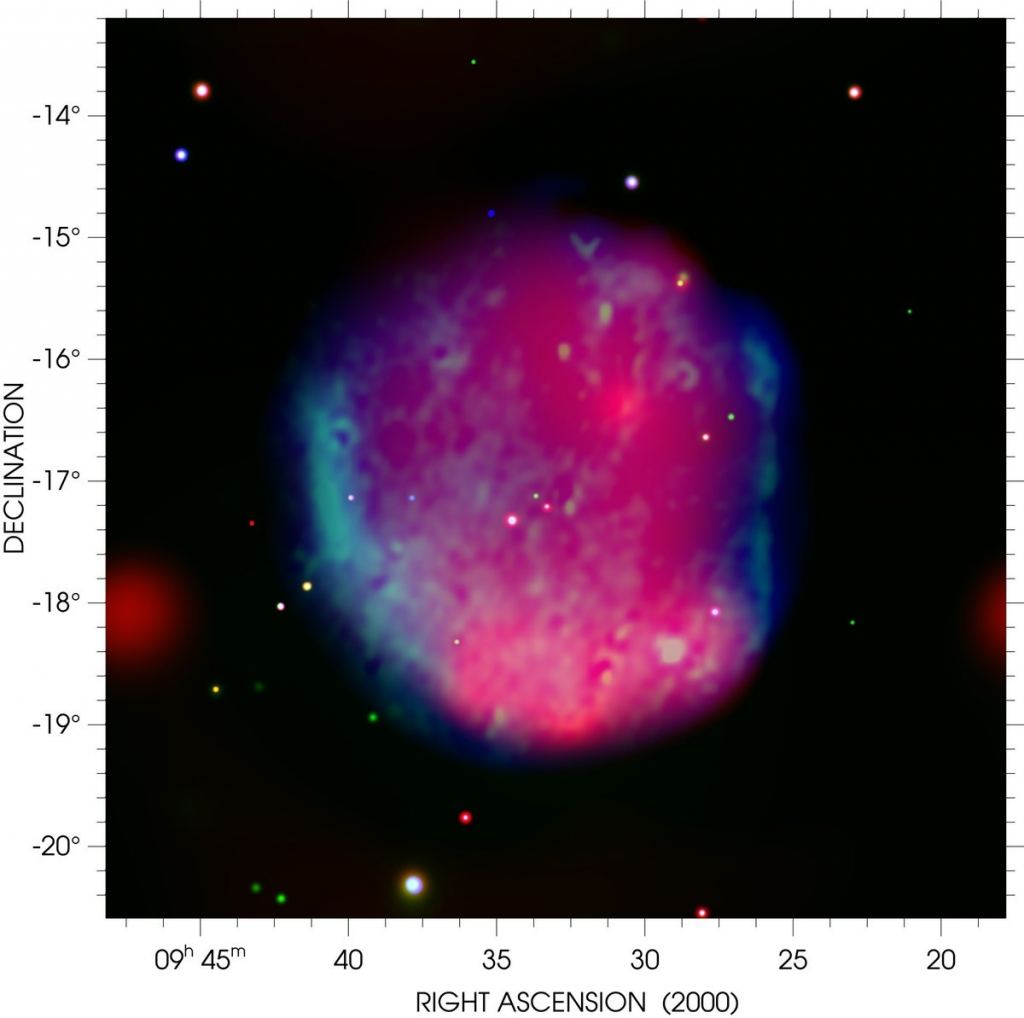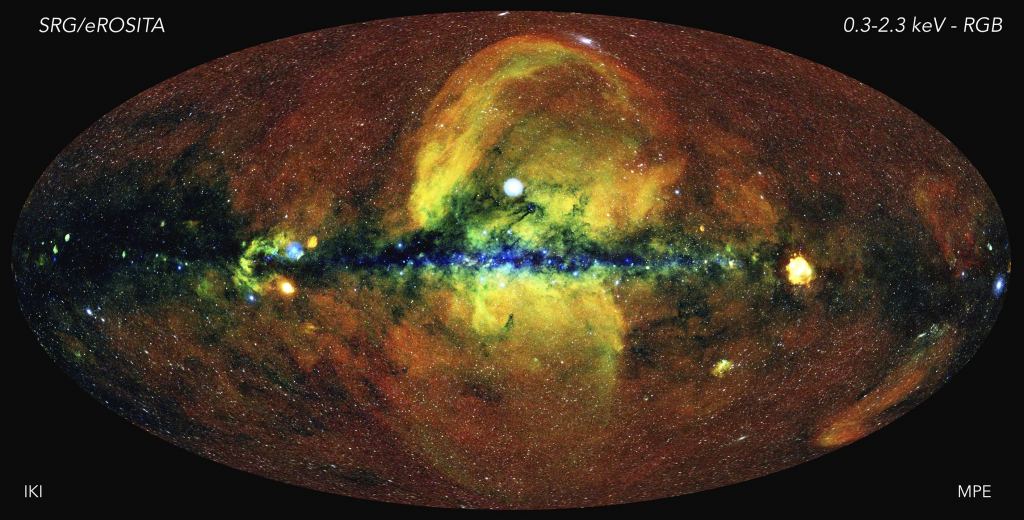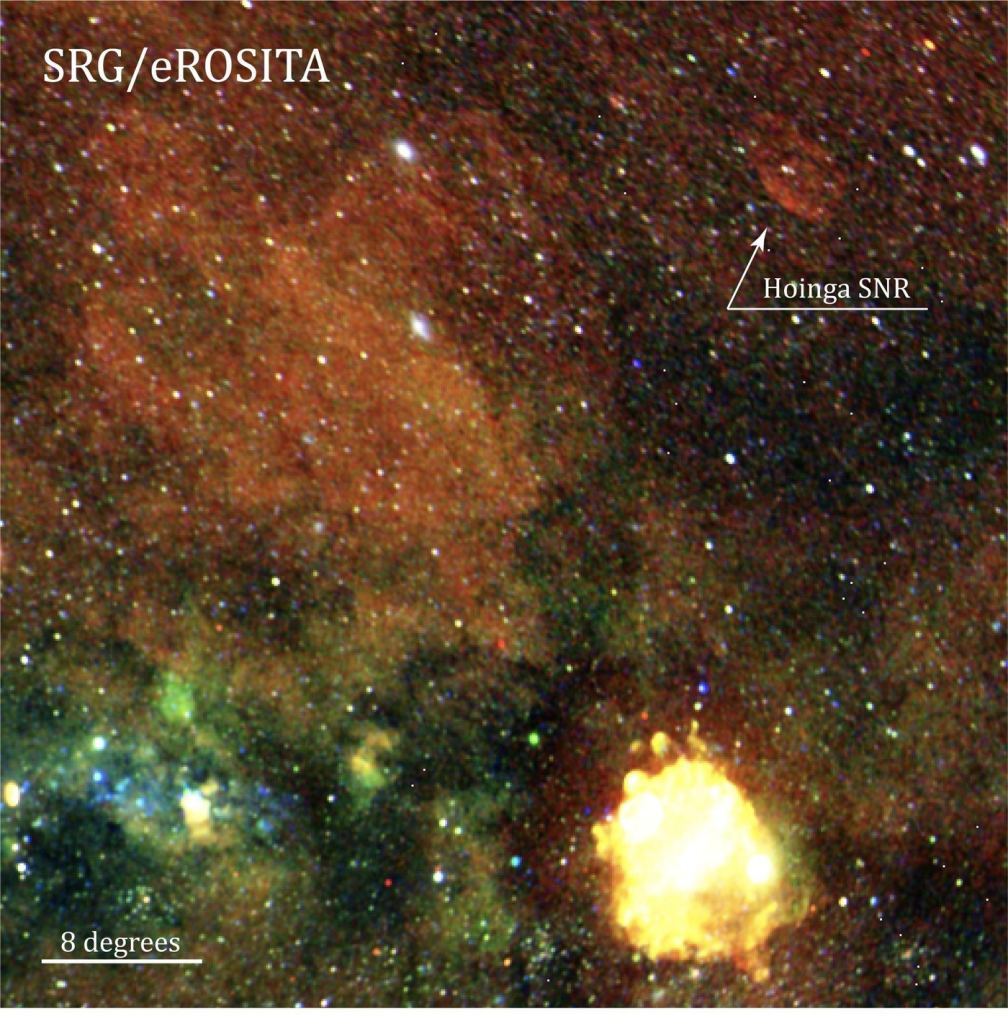An All-Sky X-Ray Survey Finds the Biggest Supernova Remnant Ever Seen
By Matthew Cimone
Our sky is missing supernovas. Stars live for millions or billions of years. But given the sheer number of stars in the Milky Way, we should still expect these cataclysmic stellar deaths every 30-50 years. Few of those explosions will be within naked-eye-range of Earth. Nova is from the Latin meaning “new”. Over the last 2000 years, humans have seen about seven “new” stars appear in the sky – some bright enough to be seen during the day – until they faded after the initial explosion. While we haven’t seen a new star appear in the sky for over 400 years, we can see the aftermath with telescopes – supernova remnants (SNRs) – the hot expanding gases of stellar explosions. SNRs are visible up to a 150,000 years before fading into the Galaxy. So, doing the math, there should be about 1200 visible SNRs in our sky but we’ve only managed to find about 300. That was until “Hoinga” was recently discovered. Named after the hometown of first author Scientist Werner Becker, whose research team found the SNR using the eROSITA All-Sky X-ray survey, Hoinga is one of the largest SNRs ever seen.

Credit: eROSITA/MPE (X-ray), CHIPASS/SPASS/N. Hurley-Walker, ICRAR-Curtin (Radio)
Hiding Giant
Hoinga is big. Really big. The SNR spans 4 degrees of the sky – eight times wider than the Full Moon. The obvious question – how could astronomers not have already found something THAT enormous? Hoinga is not where we typically are looking for supernova. Most of our SNR searches are focused on the plane of the Galaxy toward the Milky Way’s core where we’d expect to find the densest concentration of older and exploded stars. But Hoinga was found at high latitudes off the plane of the Galaxy.
Furthermore, Hoinga hides in the sky because it’s so large. At this scale, the SNR is difficult to distinguish from other large structures of dust and gas that make up the Galaxy known as the “Galactic Cirrus.” It’s like trying to see an individual cloud in an overcast sky. The Galactic Cirrus also outshines Hoinga in radio light, often used to search for SNRs, forcing Hoinga to hide in the background. Cross referencing with older radio sky surveys, the research team determined Hoinga had been observed before but was never identified as an SNR due to its comparatively faint glow in radio. Here eROSITA has an advantage as it sees X-rays. Hoinga shines brighter in X-ray light than the Galactic Cirrus allowing it to stand out from the Galaxy to be discovered.

The Progenitor
As stars age, burning through their hydrogen fuel supply, they will end their lives in different ways depending on their mass. Lower mass stars like our Sun swell to red giants eventually shedding their outer layers into space. The star’s spent core is revealed beneath the shed layers – a highly compressed hot glowing orb of carbon about the size of Earth known as a white dwarf. It’s basically a planet-sized hot space diamond. No dramatic explosion. They will cool over eons to become a “black dwarf”. Astonishingly, the Universe itself is not old enough for any white dwarf to have fully cooled to a black dwarf yet. 99% of stars will end their lives this way. However, given a push, white dwarf stars can still sometimes create supernova.
White dwarfs aren’t generating new energy rather they are bleeding off residual heat into space. However, if entangled by gravity in a binary pair with another star, material from the companion star can be drawn by onto the white dwarf. If the white dwarf collects enough material to cross a critical threshold of 1.44 solar masses (the mass of our Sun), a “runaway” reaction occurs where a large fraction of the super-dense star undergoes simultaneous nuclear fusion…in just a few seconds. Temperatures soar to billions of degrees (the core of our own Sun is a cool 15 million by comparison) and the star achieves what astronomers calmly call “unbinding energy” – BOOM! Supernovas from white dwarfs are classified as Type Ia Supernovas.

By contrast, the top 1% most massive stars go supernova on their own without the need for a companion to draw material from. These stars explode and create exotic objects in the form of black holes or pulsars – a super-super-dense object weighing several solar masses crammed into a 15km sphere. Explosions of massive stars are known as “core collapse supernovas” or Type II. Pulsars and black holes are sources of X-rays within the surrounding SNR. However, Hoinga doesn’t feature a central X-ray object. There are 11 X-ray “point sources” (not diffuse gas but concentrated points of energy) located visibly “inside” the Hoinga SNR that could be pulsars or black holes. However these sources seem to be in the foreground or background. With no central X-ray source, it is likely that the progenitor star of Hoinga was a white dwarf. Unlike a massive star exploding and leaving behind the core that becomes a pulsar or black hole, a white dwarf was the remaining core of a star. When it explodes, the point source is destroyed.
Into the Light
Determining the other characteristics of Hoinga is difficult because the SNR is located outside the galactic plane away from other objects we can use for reference. When SNRs are located in the galactic plane, they are surrounded by pulsars whose distance are easier to measure than diffuse gas clouds. There are no known pulsars within 20 degrees of Hoinga in the sky. The research team provides a distance measurement then by comparison to other known SNRs.
In regions of space like the Magellanic Clouds – satellite galaxies of the Milky Way with massive star forming regions – we see SNRs with similar brightness and shape as Hoinga with known distances. Drawing contrasts and similarities, the researchers conclude the distance to Hoinga must be at least 450 parsecs (about 1470 light years). We also know that most observed SNRs with Hoinga’s shape are not larger than 100pc (326 light years) in diameter. Knowing how wide the SNR is also gives us clues to its distance which suggest Hoinga is at most 1200 parsecs (3900 light years) away. So now we have a max and min distance.

Researchers can also infer the distance based on observations to another very well known supernova called Vela. Vela exploded about 12,000 years ago creating a pulsar. The resulting SNR is one of the most incredible images of space I’ve ever seen. Knowing how bright Vela is, we can compare the two remnants as another point of data to narrow down our 450-1200pc range to determine that Hoinga likely resides 500pc (1630 light years) from Earth.
Energy in the Dark
eROSITA made the Hoinga discovery with just one pass of its All-Sky X-ray Survey providing hope that more hidden SNRs are ready to be found. The device scans the whole sky at a rate of 0.025 degrees each second completing a scan every six months. Launched in July 2019, the first scan was completed June 12 2020 with eight total surveys planned over 4 years. eROSITA is itself the primary instrument onboard the Russian-German “Spectrum-Roentgen-Gamma” or “SGR” mission launched from Baikonur Kazakhstan. While several missions are performing All-Sky surveys, SGR was the first to complete an All-Sky survey in X-rays.
Outside of supernova hunting, SGR is observing the motions of galaxy clusters in order to gain insights into “Dark Energy” the little-understood force believed to be the cause of the Universe’s expansion. Like the upcoming James Webb Space Telescope, SGR is not orbiting Earth, but is rather parked at “L2” or Lagrange 2, a gravitational pocket of sorts created by the interaction of the Earth, Sun, and Moon (think of it like those swirling eddies in the water that follow you in a boat. If foam or debris gets caught in the eddy, they comes along with you for the ride). As X-rays are absorbed by the Earth’s atmosphere, better to put your X-ray telescope in space where SGR lives.

With each pass of the All-Sky survey, more details about objects like Hoinga will be revealed. Combined with other ongoing all-sky surveys, and giant new telescope projects, we’re accumulating more data about the sky than ever before. We’re likely to find many more SNRs, and more cool stuff about the Universe that ultimately helps us understand ourselves. Supernova made us! Stars cook up elements as heavy as nickel and iron, but everything heavier than them on the periodic table is created by these stellar explosions which then seed the raw material of our very existence through the Cosmos. We have evidence our own solar system was enriched with supernova debris as far back as 4.567 billion years ago. Seeing the remnants of these explosions is to better know the forces that brought us to be.
More to Explore:
Press Release Article: Hoinga SNR | Max Planck Institute for extraterrestrial Physics (mpg.de)
Original Research Publication (Open Access)
Astronomy Without A Telescope – Alchemy By Supernova – Universe Today
eROSITA (@eROSITA_SRG) / Twitter
eROSITA | Max Planck Institute for extraterrestrial Physics (mpg.de)
Vela Supernova Remnant Mosaic | Science Mission Directorate (nasa.gov)
Bad Astronomy | The Vela supernova remnant is an area of chaos in the sky (syfy.com)
The post An All-Sky X-Ray Survey Finds the Biggest Supernova Remnant Ever Seen appeared first on Universe Today.

March 20, 2021 at 04:57AM
via Universe Today read more...


Post a Comment